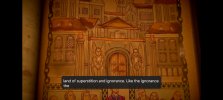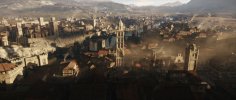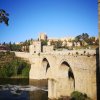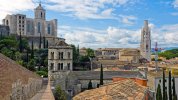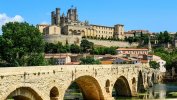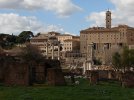Fin didn't apply for anything, he just built tests, like others did, too. We decided to take one as the base for the server build. We likely do something like this with the other two server builds.
-
The Spring 2023 edition of The Rookery is now out! Take a look to see the latest builds, guides, progress and development updates on the upcoming 1.18.2 switch. You can read it here:
https://indd.adobe.com/view/f943da18-ed77-4d55-845d-fee9bfa14247
You are using an out of date browser. It may not display this or other websites correctly.
You should upgrade or use an alternative browser.
You should upgrade or use an alternative browser.
Our aim is to not only build the best version of these projects that we are capable of, but also one that is as inclusive as possible and that ideally manages to integrate as many ideas as possible. This balance is delicate, and the more people show interest in a project, the more difficult it becomes to keep it.
...we don't just want to copy it in, and we want as many people as possible to be able to recognize themselves and their creativity in the finished build as possible.
Hear hear! A challenge indeed. I implore people to remain open minded about what the finished product will look like, it will make organizing the build a much smoother and more enjoyable process. I've always found in leading a project (irl as well) that listening to your team and giving them a high degree of creative input, instead of forcing your "vision" onto everyone, almost always results in a more rewarding experience and better result.
As with all major server builds, the leader(s) will be appointed by a mod consensus. That is because while we have a great many people perfectly capable of building us a decent Starry Sept, leading a server build comes with an entirely different set of skills required of the leader(s) - at least speaking from my personal experience with leading and participating in server builds since 2012.
Our most prestigious projects usually have a huge number of stakeholders - everyone has their own vision for a famous place like Winterfell or the Red Keep, or the Starry Sept, Citadel and the Hightower in Oldtown. Our aim is to not only build the best version of these projects that we are capable of, but also one that is as inclusive as possible and that ideally manages to integrate as many ideas as possible. This balance is delicate, and the more people show interest in a project, the more difficult it becomes to keep it. This is why we usually very carefully decide on who is to lead such a project - and the criteria that we look for in that person(s) focus more on leadership, communication, authority, fairness and more rather than actual building skills.
We all know there is probably a great number of builders we could simply task to build the thing for us and it would turn out nicely. But as I said, we don't just want to copy it in, and we want as many people as possible to be able to recognize themselves and their creativity in the finished build as possible.
This is why there will not be the possibility to apply for the general leadership of a project like the Starry Sept, the Hightower or the Citadel in Oldtown, but there will be opportunities within those projects:
Like we did in Winterfell or the Red Keep, the projects will be divided into smaller parts and people will be able to lead small teams focusing on those, within the constraints set by the overall leadership. For instance, in Winterfell people were able to lead e.g. the library tower or the great hall, and others were able to contribute to those, while the general layouts, styles and palettes were defined by Thamus. We will do something similar with the three big server projects in Oldtown.
Fin didn't apply for anything, he just built tests, like others did, too. We decided to take one as the base for the server build. We likely do something like this with the other two server builds.
So to clarify, the main monuments like the Starry Sept and Hightower proper will be chosen by the leads but surrounding builds of lesser importance will have their own sub leaders in the same way that Winterfell’s Library tower did?
Not surrounding builds, but small parts of the same project. The library tower is still a part of the Winterfell project, but was a sort of sub-project to the overarching Winterfell project. Ark and Dragons lead the entire Battle Isle project, the Hightower is the most significant part of it. We might chop it up into smaller pieces and let people have a go at different parts of it (not decided yet in detail). The secondary buildings you find on the Battle Isle will in most cases be up for application and small teams to work on. Same with the Citadel and the Starry Sept.So to clarify, the main monuments like the Starry Sept and Hightower proper will be chosen by the leads but surrounding builds of lesser importance will have their own sub leaders in the same way that Winterfell’s Library tower did?
Could be interesting to have a section of the city that has a prominent amount of towers
Some may remember that some time ago the possibility of incorporating towers like the ones on Bologna or San Gimignano was mentioned. I really like the idea, and it could be used as a way to add character to certains neighborhoods and districs of the city. There were 2 main explanations exposed as to why noblemen of Oldtown would build these structures: protection and prestige. Both are completely valid, but I would like to add a third one that would make them usefull rigth now: watchtowers.
The biggest merchants and traders, those whose bussines depend heavily on long-distance trade, would erect towers on top of their palaces and estates in order to use them as look-out post for patrolling the arrival and departure of their ships and fleets. These use is directly inspired on the torres-mirador de Cádiz.
Cádiz is a coastal city situated on the southwest of Spain. Located on and island off the mainland (now a peninsula), Cádiz was always a major port, since it was founded by the phoenicians almost 3000 years ago. Moving to the 1500's, when America was colonized, Castille managed the goods that came form the New World by giving just one city the privilege (the monopoly) of trading with the territories overseas. This role was played by Sevilla up until 1717, when the port at the Guadalquivir (the river that runs througth Sevilla) became clogged with silt, and Cadiz was given the monopoly. During almost a century Cádiz was the only city where trade with America was possible. Just like Sevilla before, this lead to the establishment of many merchats and bourgeois in the city. Now is when this newly created merchant class builds this towers as a way of controling their source of income.
Sooner than later to the practical use of this structures was added the prestigious aura that having a tower gave to the residence of a merchant. Many begun to build more than one tower per palace, leading to the prohibition of having more than one per house (some palaces were split into smaller residences to skip the normative).

Common merchant house in Cádiz in the XVIII century. It resembles other merchant houses aroun the Mediterranean, like the ones in Vencice, with the exception of the watchtower.

Torre Tavira, the highest torre-mirador in Cádiz.

View of the rooftops of Cádiz. There are about 130 torres-mirador in Cádiz, from 160 at the height of the trend.

Another view of the city rooftops.

Main 4 types of torres-mirador: terraza (flat top), sillón (two levels), garita (with a small structure on top) and mixta (combination of the other 3 types).
Adding a "practical" use to the towers would make them have a reason to be build and maintained besides prestige (not that humans won't do something costly just to brag, there are thousands of examples historically), and above all, would limit them to a certain class of the city (merchants). This way just some districts of Oldtown would have towers, making them more unique and differentiating those neirghborhoods form other places of the city.
My proposal would be to use the style of the towers in Bologna and San Gimignano, the ones alredy discussed here, but adding the fuctionality of the torres-mirador of Cádiz. If for some reason this idea is ditched, I think some city on Essos would benefit from it anyways (Pentos is said to have many square brick towers and could have originated a trend that merchants of other cities copied).
Last edited:
¡A mí me encantan las Torres, serán inspiraciones fantásticas por Dorne!slowly takes out presentation to raise the mood back
Some may remember that some time ago the possibility of incorporating towers like the ones on Bologna or San Gimignano was mentioned. I really like the idea, and it could be used as a way to add character to certains neighborhoods and districs of the city. There were 2 main explanations exposed as to why noblemen of Oldtown would build these structures: protection and prestige. Both are completely valid, but I would like to add a third one that would make them usefull rigth now: watchtowers.
The biggest merchants and traders, those whose bussines depend heavily on long-distance trade, would erect towers on top of their palaces and estates in order to use them as look-out post for patrolling the arrival and departure of their ships and fleets. These use is directly inspired on the torres-mirador de Cádiz.
Cádiz is a coastal city situated on the southwest of Spain. Located on and island off the mainland (now a peninsula), Cádiz was always a major port, since it was founded by the phoenicians almost 3000 years ago. Moving to the 1500's, when America was colonized, Castille managed the goods that came form the New World by giving just one city the privilege (the monopoly) of trading with the territories overseas. This role was played by Sevilla up until 1717, when the port at the Guadalquivir (the river that runs througth Sevilla) became clogged with silt, and Cadiz was given the monopoly. During almost a century Cádiz was the only city where trade with America was possible. Just like Sevilla before, this lead to the establishment of many merchats and bourgeois in the city. Now is when this newly created merchant class builds this towers as a way of controling their source of income.
Sooner than later to the practical use of this structures was added the prestigious aura that having a tower gave to the residence of a merchant. Many begun to build more than one tower per palace, leading to the prohibition of having more than one per house (some palaces were split into smaller residences to skip the normative).
View attachment 7053
Common merchant house in Cádiz in the XVIII century. It resembles other merchant houses aroun the Mediterranean, like the ones in Vencice, with the exception of the watchtower.
View attachment 7055
Torre Tavira, the highest torre-mirador in Cádiz.
View attachment 7057
View of the rooftops of Cádiz. There are about 130 torres-mirador in Cádiz, from 160 at the height of the trend.
View attachment 7056
Another view of the city rooftops.
View attachment 7054
Main 4 types of torres-mirador: terraza (flat top), sillón (two levels), garita (with a small structure on top) and mixta (combination of the other 3 types).
Adding a "practical" use to the towers would make them have a reason to be build and maintained besides prestige (not that humans won't do something costly just to brag, there are thousands of examples historically), and above all, would limit them to a certain class of the city (merchants). This way just some districts of Oldtown would have towers, making them more unique and differentiating those neirghborhoods form other places of the city.
My proposal would be to use the style of the towers in Bologna and San Gimignano, the ones alredy discussed here, but adding the fuctionality that the torres-mirador of Cádiz developed. If for some reason this idea is ditched, I think some city on Essos would benefit from it anyways (Pentos is said to have many square birck towers and could have originated a trend that merchants of other cities copied).
Well, apparently they were influeced by some kind of North African tradition, so... There are many lookout towers in Spanish cities that trace back to al-Ándalus, but used for leisure and viewing the landscape. But that's for another time¡A mí me encantan las Torres, serán inspiraciones fantásticas por Dorne!
EDIT: I would make a post about it in inspo.
Last edited:
Hey Azulejo, thats very interesting, specially cause u can see that influence later in the colonies, here in Montevideo we have a tipe of house with those towers near the port, of course not in a medieval style.Well, apparently they were influeced by some kind of North African tradition, so... There are many lookout towers in Spanish cities that trace back to al-Ándalus, but used for leisure and viewing the landscape. But that's for another time
I'll reread the book and make a long-form writeup. The University is very similar - there is a scholarly Archmaester class, there are different classes of student, both the arcane and mundane are studied, there's insight into the daily lives of the students and there's also lots of detail about the supporting buildings and personnel needed for such a institution
Last edited:
Reading the other YA books is taking some time. In the meantime, here's two inspiration images from the server. The first is the facade for the Citadel (sourced from the TV documentary) and the second is a good stylistic inspiration, especially regarding inner walls and tower density (by Enah, Baldurs Gate screenshot).
If we are going for a Constantinople look, we could design squares, open areas and stalls based on Assassin's Creed Revelations, although we would be neutering the Arab/Islamic design creep visible all over the city. No rug banners!
Is there any discussion of local flora in this thread? Oldtown probably wouldn't have palm trees, blossom or oak trees would be the way forward IMHO: https://www.hurriyetdailynews.com/photo-rumelian-fortress-with-judas-trees-in-istanbul-154232
If we are going for a Constantinople look, we could design squares, open areas and stalls based on Assassin's Creed Revelations, although we would be neutering the Arab/Islamic design creep visible all over the city. No rug banners!
Is there any discussion of local flora in this thread? Oldtown probably wouldn't have palm trees, blossom or oak trees would be the way forward IMHO: https://www.hurriyetdailynews.com/photo-rumelian-fortress-with-judas-trees-in-istanbul-154232
Attachments
Last edited:
There is a lot of discussion of flora in the OT doc iirc, which outlines the plans for the city. Currently finishing touches to that document and the groundwork for plotting is underway, which is what the OT teams are doing with the sewers, canals, defences and terrain.
That image of the facade with the sphinxes is incredible. Somehow it reminds me of the pliska cathedral
That image of the facade with the sphinxes is incredible. Somehow it reminds me of the pliska cathedral
So what's the deal with the black stone base of the Hightower. Was it an ancient Valyrian outpost or was it made by those Deep Ones weirdos behind the Seastone Chair.
All the Deep Ones lore seems to be leaning heavily into Lovecraft/Cthulu mythos. Are we talking full on R'lyeh, non-euclydian geometry Mountains of Madness.



How far would we take this in-game. The exterior seems to be straight forward enough, but what could be included inside it? Some areas would be relatively accessible to the occupants and repurposed for storage etc over the years, but there could be secret, sealed off parts that hide some crazy secrets that could be fun to explore.
All the Deep Ones lore seems to be leaning heavily into Lovecraft/Cthulu mythos. Are we talking full on R'lyeh, non-euclydian geometry Mountains of Madness.



How far would we take this in-game. The exterior seems to be straight forward enough, but what could be included inside it? Some areas would be relatively accessible to the occupants and repurposed for storage etc over the years, but there could be secret, sealed off parts that hide some crazy secrets that could be fun to explore.
We go all out madness. Emote has been testing for this for ages on his plot, afterall.
I love the mysterious feeling that surrounds black stone. In case someone needs some refreshing this video is great, briefly listing all the examples of non valyrian black stone, both oily and fused. Also there was a reddit post that explored the link between the Deep Ones and the Black Stone but I can't seem to find it (found it: 1, 2, 3). Basically it said that the Deep Ones where dragonlords before the valyrians, and that they used sea dragons to make the structures all over Planetos. First they were oily and then, when their techniques where perfected, fused. There's also the fact that the Hightower is on Batlle Isle, but there isn't any record of a battle taking place there.
Anyways I think, as Spike suggested, we should go all out. Man made or not, is something weird, unknow and one could argue something the Hightowers are taking advantage of or keeping out of the public eye. It should feel like nothing anywhere on the continent, not following common architecture techniques, like vault celings and such.
I've tried making a rough mockup of what I imagine the interiors could be. I went with an oval shape, partially because on the reddit post I mentioned it was suggested Deep Ones flooded the tunnels inside the Battle Isle structure to travel easily around it, and also because I thought it'd feel extrange and not like anything built later on. That's why the different tunnels would probably be connected at unconfortable heights and some would feature steep drops/climbs unable to be done by foot, or straight shafts up and down (something that would play well on the non-euclydian inspo). Here precarious structures made of rope or wood would be made to reach the different areas of the maze.
Anyways I think, as Spike suggested, we should go all out. Man made or not, is something weird, unknow and one could argue something the Hightowers are taking advantage of or keeping out of the public eye. It should feel like nothing anywhere on the continent, not following common architecture techniques, like vault celings and such.
I've tried making a rough mockup of what I imagine the interiors could be. I went with an oval shape, partially because on the reddit post I mentioned it was suggested Deep Ones flooded the tunnels inside the Battle Isle structure to travel easily around it, and also because I thought it'd feel extrange and not like anything built later on. That's why the different tunnels would probably be connected at unconfortable heights and some would feature steep drops/climbs unable to be done by foot, or straight shafts up and down (something that would play well on the non-euclydian inspo). Here precarious structures made of rope or wood would be made to reach the different areas of the maze.
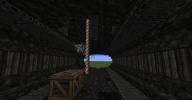
I'm a fan of this elongated oval
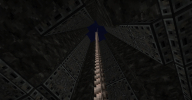
Vertical shaft with a rope to access it

I'm not sold on the wear and tear of the fused black stone. It adds texture and visual interest, but it doesn't seem like this type of stone is prone to breaking off
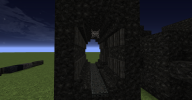
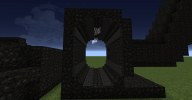
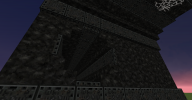
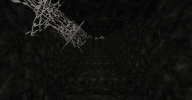
Steep vertical shaft (view bottom to top)
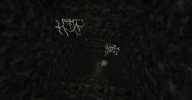
Steep vertical shaft (view top to bottom)
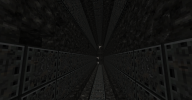
A more slim and tall passage
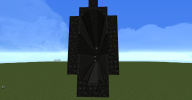
There are some drawbacks with this design, mainly because having curved walls makes adding decorations and clutter kind of hard, as it usually must be put right on the middle of the passage. Also two new blocks would need to be added (valyrian stone halfdoor and valyrian stone "trapdoor"). Curves, cornes and diagonal tunnels are hard to make nicely too. And it has alien spaceship vibes, to an extent.
Last edited:
What about several large chambers with many doorways leading off from them all around the room at innaccessible spots, but with what look like staircases extending from the ceiling to those?
I'm sorry if this isn't the right place, but I wanted to give my own thoughts on the base of the Hightower. The discussions about the black stone interest me because I don't really agree with you about using Lovecraftian inspiration. The Great Empire of the Dawn also used black stone and far more prolifically, such as for the Five Forts. Maybe the base of the Hightower was built by that Empire or craftsmen of it? Maybe the Dawn Empire was far larger than we thought and it had connections as far as Westeros? We don't have any evidence for the Deep Ones being able to make full buildings in black stone apart from at the Hightower, and maybe the Hightower actually has no connection to the Deep Ones at all?
Last edited:
Here's the quote from AWOIAF that makes the Deep One's connection.
I like the idea of going with Valyria or a Deep Ones influence rather than making a connection to the Empire of the Dawn that hasn't been brought up in the books yet.
But it's all basically speculation anyway, we can go with what works the best with our blocks and sensibilities.
The stony island where the Hightower stands is known as Battle Isle even in our oldest records, but why? What battle was fought there? When? Between which lords, which kings, which races? Even the singers are largely silent on these matters.
Even more enigmatic to scholars and historians is the great square fortress of black stone that dominates that isle. For most of recorded history, this monumental edifice has served as the foundation and lowest level of the Hightower, yet we know for a certainty that it predates the upper levels of the tower by thousands of years.
Who built it? When? Why? Most maesters accept the common wisdom that declares it to be of Valyrian construction, for its massive walls and labyrinthine interiors are all of solid rock, with no hint of joins or mortar, no chisel marks of any kind, a type of construction that is seen elsewhere, most notably in the dragonroads of the Freehold of Valyria, and the Black Walls that protect the heart of Old Volantis. The dragonlords of Valryia, as is well-known, possessed the art of turning stone to liquid with dragonflame, shaping it as they would, then fusing it harder than iron, steel, or granite.
More troubling, and more worthy of consideration, are the arguments put forth by those who claim that the first fortress is not Valyrian at all.
The fused black stone of which it is made suggests Valyria, but the plain, unadorned style of architecture does not, for the dragonlords loved little more than twisting stone into strange, fanciful, and ornate shapes. Within, the narrow, twisting, windowless passages strike many as being tunnels rather than halls; it is very easy to get lost amongst their turnings. Mayhaps this is no more than a defensive measure designed to confound attackers, but it too is singularly un-Valyrian. The labyrinthine nature of its interior architecture has led Archmaester Quillion to suggest that the fortress might have been the work of the mazemakers, a mysterious people who left remnants of their vanished civilization upon Lorath in the Shivering Sea. The notion is intriguing but raises more questions than it answers.
An even more fanciful possibility was put forth a century ago by Maester Theron. Born a bastard on the Iron Islands, Theron noted a certain likeness between the black stone of the ancient fortress and that of the Seastone Chair, the high seat of House Greyjoy of Pyke, whose origins are similarly ancient and mysterious. Theron's rather inchoate manuscript Strange Stone postulates that both fortress and seat might be the work of a queer, misshapen race of half men sired by creatures of the salt seas upon human women. These Deep Ones, as he names them, are the seed from which our legends of merlings have grown, he argues, whilst their terrible fathers are the truth behind the Drowned God of the ironborn.
I like the idea of going with Valyria or a Deep Ones influence rather than making a connection to the Empire of the Dawn that hasn't been brought up in the books yet.
But it's all basically speculation anyway, we can go with what works the best with our blocks and sensibilities.
Share:










